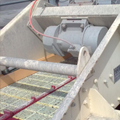INCLINED SCREENS FOR MINERAL PROCESSING
May 11, 2017
It’s not exactly hard to see why inclined screens work so well in a mineral processing application. Gravity is being employed as a supplementary material actuation mechanism, right? The angled deck is sending the loose mineral stream down towards a conveyor or some other processing station. Okay, that image seems to explain this tilted design, but there’s more to this equipment than gravity-induced material propulsion.
ADJUSTABLE STROKE ANGLE
Less horsepower is required in this tilted screening configuration because gravity is supplementing the material flow. The mineral stream will accelerate down the inclined screen when that tilt increases, but there comes a point when this angle no longer benefits the screening process. Typically, this vibrating deck shouldn’t be adjusted higher than 60°. Set higher than this angular limit, the coarse particles impede each other and slow the rate of travel. Therefore, a 30° to 60° pitch blends the G-forces and vibrational energy properly. Incidentally, the adjustments are made by fine-tuning a locking key bolt.
PROFILING THE STROKE
The above changes account for hi-flow streams and larger than average rocks. Next, this equipment harnesses vertical and horizontal forces, although they combine to produce diagonal momentum along the screening deck. It’s because of this feature that the stroke shape can be managed. For example, a symmetrical stroke cycle creates a corkscrewing vibrational effect, but a few adjustments to the eccentrically mounted gears can transform that vibrational profile. Oval throw patterns and straight-line “kicks” are implemented when these alterations are introduced.
PRODUCTIVITY-GEARED EQUIPMENT
If numbers are important, we’ll talk about numbers. In this case, the number four is the most important figure in inclined screen engineering. Four inclined screen types dominate this industry, so let’s describe this productivity-centric quartet. First of all, a single deck machine tops this group, then there’s a double inclination model and its triple inclination sibling. Finally, a multi-inclination screening solution comes in the form of the colourfully labelled banana screen. So-called because of its curved deck, a banana screen is equipped with a relatively small footprint but can process large material volumes due to its multi-slope design.
When we refer to inclined screens for material processing applications, deck tilting, stroke angles, and vibrational profiles come into play. The design also accommodates a gravity-feed feature, so G-force excitation is also a relevant equipment specification, one that’s often provided on the equipment datasheet. Finally, the actual aperture profiles, the holes that perforate the screens, deserve a mention. After all, a horizontal screen drops its sorted minerals straight down, but the angled screen openings must account for an inclined screens’ vibrational orientation.
Optimized by: Netwizard SEO
